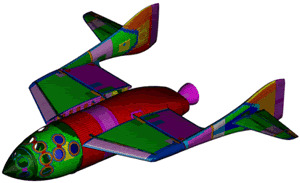Aeroelastic Analysis.
EXTENSIVE AEROELASTIC CAPABILITIES
Quartus has extensive capabilities for performing aeroelastic analysis. Capabilities include:
- Flutter
- Divergence
- Gust and random response
- Static aeroelastic response

SUBSONIC TO HYPERSONIC
Quartus capabilities include a suite of algorithms suited for different speed regimes.
- Doublet Lattice method (M < 1)
- Constant Pressure method (M < 3.5)
- Piston Theory (M < 5)
- ZTRAN for transonic (M ~ 1)
- ZONA6/ZONA7 for subsonic/supersonic
- ZONA7U for supersonic/hypersonic

SOFTWARE
Quartus uses leading software tools for performing aeroelastic analysis.
- ZAERO®
- MSC Nastran
- NX Nastran
- Custom codes for V-G and V-F postprocessing

EXTENSIVE EXPERIENCE
Quartus personnel have extensive experience in performing aeroelastic analysis. Cases include:
- Subsonic and supersonic flutter analysis of SpaceShipOne
- Subsonic and supersonic flutter analysis of WhiteKnight Two & SpaceShipTwo
- Subsonic flutter of Stratolaunch
- Flutter analysis of Shadow 200 and M2
- Subsonic and supersonic flutter analysis of XCOR Lynx
- Predator B whirl flutter
- Pegasus and Pegasus XL captive carry (subsonic) and free flight (up to Mach 5)
- Panel flutter analysis of a supersonic missile
- Flutter and divergence analysis for the Altair high altitude research vehicle (modified Predator-B)
- Piaggio P-180 preliminary flutter analysis (elastic axis models) and detailed flutter analysis (detailed 3-D FEM)
- Piaggio P-180 wind tunnel flutter model development, analysis, and flutter test
- Tomahawk cruise missile wing and fin flutter analysis
- Ground launched cruise missile composite wing flutter analysis
- Pratt & Whitney Canada PT-6 engine/propeller whirl flutter analysis
- Windmill flutter including gyroscopic effects
- Flutter analysis for the Improved Tactical Air Launched Drone (I-TALD)



